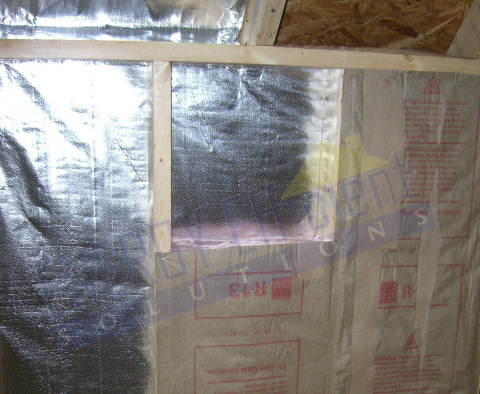We are your source for energy efficient products and information.
|
Radiant Barrier > Installation > Walls
Radiant Barrier in Walls and Crawl Spaces
Knee Walls: 
Radiant Barrier wall sheathing can be attached to the attic (exterior) side of a knee wall to cut down on radiant heat gain or heat loss in the winter. It is recommended that insulation be encapsulated on all six sides with a rigid air barrier like sheathing or foam board. If possible install sheathing on the attic side first and then cover with radiant barrier.
- 1. You should use a perforated material (ARMA FOIL™) for this application.
- 2. If there is no air barrier installed on the attic side, consider adding sheathing or foam board to encapsulate the insulation on all six sides.
- 3. Unroll the Radiant Barrier sheathing and staple to the exterior side of the wall facing the attic, overlapping each run by about 2 inches.
- 4. You should tape the seams and secure the edges to the framing to create a backside air barrier. This will help to reduce air infiltration.

This image was taken from the interior prior to radiant barrier wall installation of sheet rock.
(ARMA FOIL™ is installed on attic side and has a foil surface facing the open attic.)
Vapor Barrier: 
If your local climate or building code calls for an interior vapor barrier, Non Perforated Radiant Barrier can be used as a vapor / radon barrier. Radiant barrier in walls will reduce moisture inside the house from passing through into mass insulation.
- 1. You must use non-perforated (ARMA FOIL-VB™) material for this job.
- 2. Unroll the Radiant Barrier and staple to the interior side of the wall studs and insulation.
- 3. Overlap each run by about 2 inches.
- 4. To create a true vapor barrier, you must tape all seams and penetrations.
Proceed to Material Specifications
|